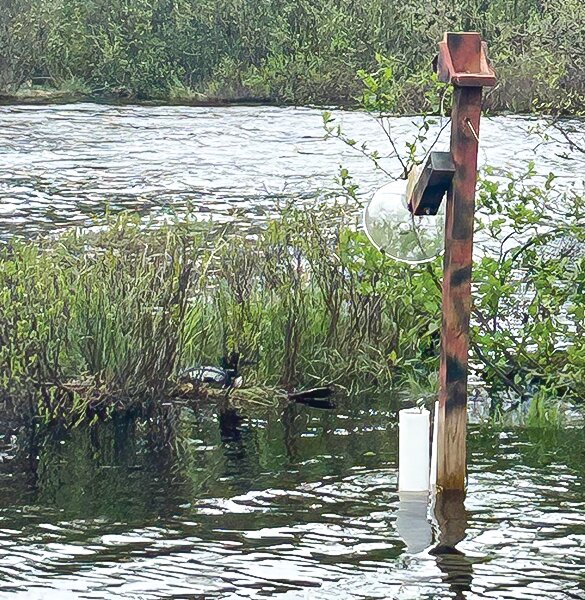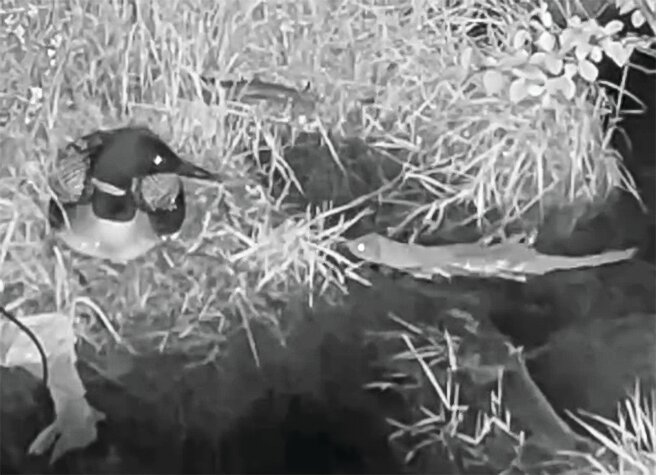Support the Timberjay by making a donation.
Loon cam sees growing following
Hatching could come as soon as this weekend
LAKE VERMILION— Interest is growing in the drama surrounding a pair of nesting loons here, who have faced rising water and a mink attack as they’ve attempted to bring the next generation …
This item is available in full to subscribers.
Attention subscribers
To continue reading, you will need to either log in to your subscriber account, below, or purchase a new subscription.
Please log in to continue |
Loon cam sees growing following
Hatching could come as soon as this weekend
LAKE VERMILION— Interest is growing in the drama surrounding a pair of nesting loons here, who have faced rising water and a mink attack as they’ve attempted to bring the next generation to life.
While the loons are one of dozens of nesting pairs on Lake Vermilion, this particular duo are the current stars of their own reality show, care of a live nest cam set up nearby courtesy of the Vermilion Lake Association.
It’s the fourth year of the nest cam, but it’s the first time the camera has been trained on this particular loon pair and the live feed has served as a witness to the struggle that many species of wildlife experience in their efforts to raise their young.
As is common with loons, which have limited ability to walk on land, this pair’s nest is right on the water’s edge, hidden in a thicket of dense spirea. According to Noel Sederstrom, who has helped manage the video feed from the camera, the loons established their nest and laid their first egg on May 13 and the second on May 15. On May 20, as documented by the camera, a mink under the cover of darkness attacked the adult loon on the nest at the time, dragging it underwater. The loon escaped but before it could get back to its nest, the mink attempted to grab one of the two eggs. The mink was unsuccessful at the time and eventually abandoned the effort when the loon surfaced again near the edge of the nest. The encounter can be viewed on the lake association’s Facebook page in a short video excerpt posted there. If the mink attack wasn’t enough, the area received two to four inches of rain a few days later, which pushed water levels significantly higher on rivers and lakes around the region. As the lake level rose, the loons added material to their nest and repositioned their eggs in an effort to avoid the rising water, which could flood the nest.
At some point, one of the loon eggs was lost, although it’s unclear how that happened. The camera lost its internet connection when its ethernet cable was severed by something (they suspect a beaver chewed through it), which had the live feed out of commission for a week. By the time the camera crew had the feed re-established, the egg had gone missing.
Now, the focus remains on the successful hatching of the one remaining egg, which could come as early as this weekend, based on the average incubation period for loons of 25-29 days.
Sederstrom is hopeful the camera will be working again by the time the egg hatches. Thunderstorms Tuesday night knocked the camera out of commission again, but volunteers were back on the scene making repairs as the Timberjay went to press. The inch of rain that fell overnight posed additional challenges as the water level was on the rise again, forcing the loons to adjust their nest to save their egg.
Unlike many other birds, which are hatched featherless and blind, the hoped-for hatching of the loon’s egg will quickly bring a halt to the action at the nest. Young loons are precocious from the start and will typically remain in the nest only a day or two after hatching. They can dive and swim underwater at just 2-3 days of age and are able to fly in 10-11 weeks on average. That assumes they can avoid a wide range of other predators out there in the wild.
Upgrades this year
This year’s set-up is not only at a new location, it also includes a new camera and a parabolic dish around the microphone that gathers the sound around the nest much better and helps to filter out some of the extraneous noise, such as supposedly private conversations on boats or nearby docks that used to be picked up by the sensitive instrument. “The sound is really amazing now,” according to Sederstrom.
Sederstrom said the new camera has remote focusing and zoom which allows him to change the image scale right from his home computer. The new camera, which went from a five megapixel resolution to two megapixel offers somewhat lower resolution but has cleared up some of the problems they used to have with freeze-ups due to insufficient internet capacity. He said most cameras serving a live feed require a minimum of a ten-meg upload speed. “We’ve been limping along at four or five,” he said.
But that hasn’t seemed to dampen enthusiasm for the feed. While they don’t know how many people are viewing the live feed at any one time, Sederstrom notes that some of the video segments they’ve recently posted have already had over 3,500 views. “We all dreamed that it would be really cool and important for a lot of people,” said Sederstrom. “There’s only a handful of these loon cams around the country.
A coordinated effort
The nest cam is the culmination of work by a number of individuals working on behalf of the Vermilion Lake Association and it can be viewed on the organization’s website at www.vermilionlakeassociation.org. That includes Sederstrom, now retired, who has an extensive background in broadcast news, first as a reporter and later as a producer, working for stations all over the Midwest. His son Chris, who has a background in online video production, has helped with the website and posting segments of video to YouTube.
“But I think Bill Michaelson has put in the most effort,” said Sederstrom. That includes actually constructing the device that sits in the water and holds the camera in place as well as making adjustments and hooking up cables that connect the camera to a nearby router at an undisclosed location.
Michaelson’s wife Pat serves on the lake association’s board and has advocated on behalf of establishing the nest cam for the past few years.
Sederstrom also gives credit to Access Broadband, in Virginia, which has supplied the internet and other technical help with the project. “All of us are volunteering our efforts,” said Sederstrom. “It’s definitely a labor of love.”









